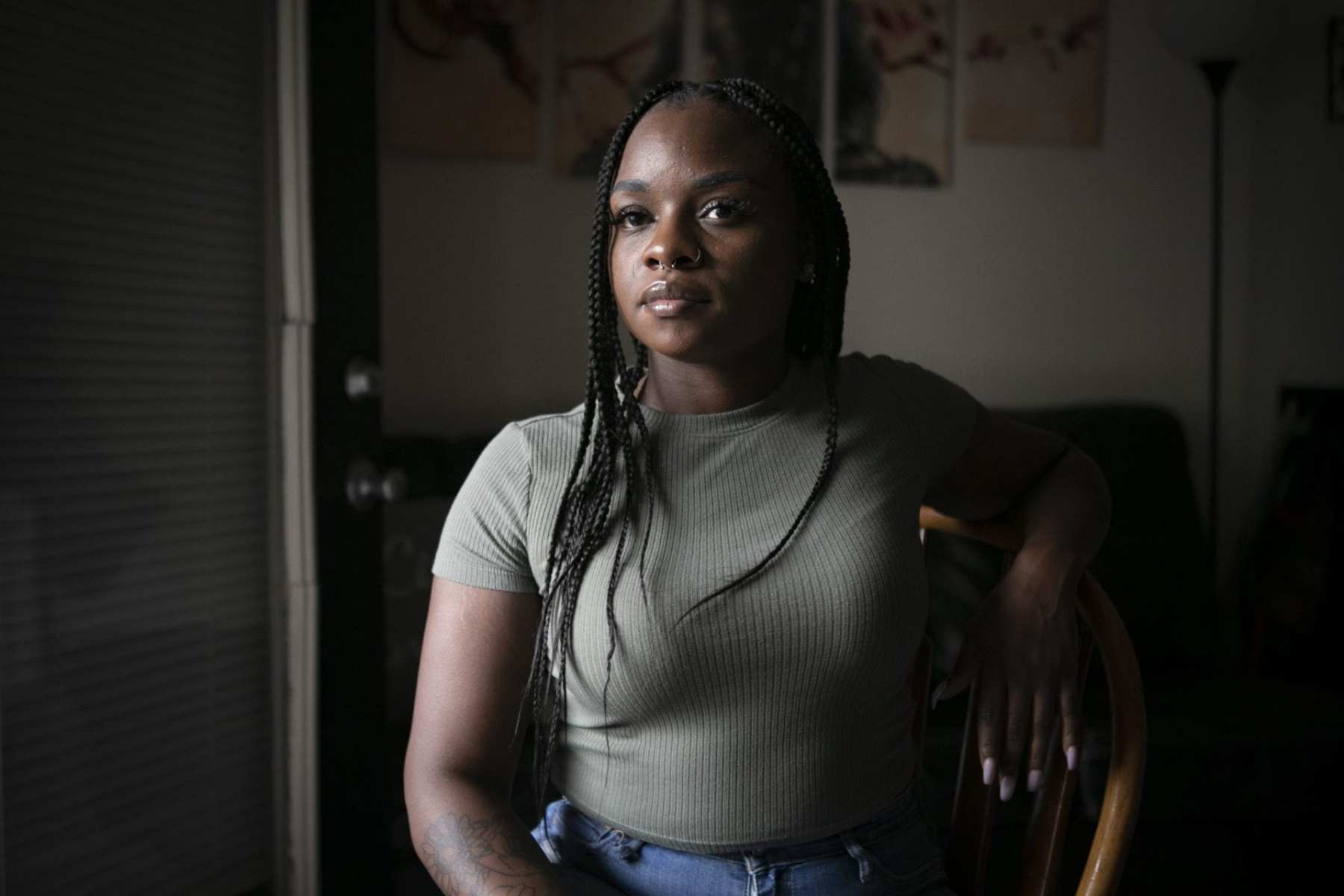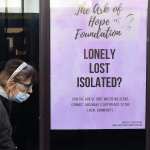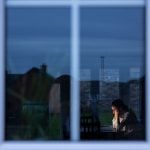Kam-Mira Joy Edwards hasn’t been able to sleep in weeks. She hasn’t menstruated since March, maybe February. Her headaches seem unending.
Edwards, a 32-year-old graduate student in clinical mental health counseling, knows she’s struggling. Since COVID-19 emerged in the United States, she’s felt symptoms of both depression and anxiety, she said.
“I come out of it, and it’s like I’ll drop back in it. But every time I drop back in it, it gets worse,” she said. “Especially with everything that’s going on.”
Edwards is going through a divorce, and her sister died in April. Either event would incur a heavy psychological toll on its own, but the pandemic has made it almost unbearable: The single mother of two, who also helps care for her father, is also trying to figure out how to approach education for her kids. Money is tight, and she can’t find full-time work.
And through it all, the isolation inherent to social distancing means she can’t lean on her usual in-person support networks. She’s tried booking appointments with a psychiatrist, but she can’t find any openings.
“This is not something I’ve ever experienced before,” she said. “I’m surprised my hair hasn’t fallen out.”
The devastating spread of COVID-19 has put a spotlight not only on physical vulnerabilities, but also on the nation’s mental health. Both depression and anxiety were already far more prevalent in women and, as early data pours in, it’s becoming increasingly clear that the pandemic has exacerbated that disparity. Experts say that much of the growth stems from the pandemic’s cultural and economic fallout: child care burdens, lost income and efforts to navigate children’s education — all of which are disproportionately affecting women. Researchers are also finding that transgender and non-binary people — who are also already at greater risk for depression and anxiety — may be facing greater psychological stress as well.
Altogether, the surge threatens to create a new stress-test for the nation’s already fragmented mental health care system, with ramifications that could play out for years.
“The pandemic, it widens existing disparities,” said Dr. Cindy Liu, an assistant professor at Harvard Medical School. “It’s going to have long-term consequences.”
Behavioral health scientists haven’t determined why women are more susceptible to depression and anxiety. But a key factor is that women typically work in lower-paying jobs and are more often put in caregiving roles. A robust body of research shows that lower wages are linked to mental disorders.
“When you don’t have enough money, when you’re taking care of someone, that is a risk factor,” said Dr. Karen Martinez Gonzalez, an associate professor of psychiatry at the University of Puerto Rico. “From what we know about women and jobs and how they are being paid, they will probably be more affected by this pandemic.”
Since the end of April, higher rates of women than men have reported symptoms of anxiety or depression, per data collected by the federal Centers for Disease Control and Prevention. As of July 14, 44 percent of women reported symptoms of at least one of the conditions, compared to 36 percent of men. About 30 percent of women indicated symptoms of only depression, compared to 26 percent of men; for only anxiety, the gap was 39.4 percent versus 31.5 percent.
Since May, polling from the Kaiser Family Foundation, a nonprofit health care research group, has consistently shown women are more likely than men to say the pandemic has negatively affected their psychological well-being. The latest data, from July, found that 57 percent of women were likely to say COVID-19 had negatively affected their mental health, compared to 50 percent of men. Women were also more likely than men to report that their deteriorating psychological health translated to adverse physical effects.
Race further compounds the issue. Since the end of April, Black and Latina women have been generally more likely than White women to report symptoms of depression or anxiety, though the gap has varied over the course of the pandemic, according to data the CDC shared with The 19th. At the end of June, 47.9 percent of Latina women and 45.8 percent of Black women reported symptoms of at least one condition, compared to 38.7 percent of White women. (In general, the difference between Black and Latina women has not been statistically significant.)
None of those datasets or surveys look specifically at nonbinary or transgender people. But observational research published this June in the Journal of General Internal Medicine found that they also experienced increases in depression and anxiety that accompanied the onset of COVID-19, a change the researchers suggest could be influenced by factors like the weakening economy, fear of the virus and social isolation. In March and April, Trans Lifeline — a peer support mental health hotline for transgender people — experienced a 78 percent increase in crisis calls, said Bri Barnett, a spokesperson for the organization.
Job insecurity is a risk factor for anxiety and depression. In general, the economic downturn has generally hit women harder than men, and Latina women have been affected more than any other group, seeing a 21 percent loss in jobs, per data analyzed by the Pew Charitable Trusts. Black women experience a 17 percent drop. Black women and Latinas also have far greater likelihood of working a job that’s been deemed essential, meaning they’re at heightened risk of going out in the world, contracting the virus and potentially passing it onto others — yet another psychological burden.
“You’re talking about two groups where the pay gap is quite dramatically different,” said Margarita Alegria, a professor at Harvard Medical School’s psychiatry department and chair of Massachusetts General Hospital’s Disparities Research Unit. “You’re talking about poverty, you’re talking about unemployment rates being higher, and you’re talking about less support.”
Data collected by the Human Rights Campaign found that 19 percent of transgender people had become unemployed because of the pandemic. Among non-White transgender people, that jumped to 26 percent.
“This isn’t surprising to us,” said Annesa Flentje, an associate professor at the University of California-San Francisco, who authored the General Internal Medicine Report. “You have a group that already had less, and was more disadvantaged, and then something like this happens.”
Early data collected by academic researchers also suggests that moms are at greatest risk because they most often shoulder the burden of homeschooling, according to a paper out of the University of Utah. It’s a psychological burden that women’s health researchers worry could re-emerge this fall, as schools’ reopening plans remain unclear at best. A June paper out of the University of Southern California found that, in two-adult, mixed-gender households, women in general were more likely to report psychological distress following the pandemic. But the burden was most pronounced for women with children.
“There’s a problem, and this is a problem that’s affecting moms more than other groups,” said Gema Zamarro, the paper’s lead author and a professor at the University of Arkansas. Zamarro was moved to do the research, she said, by her own distress while juggling parenting and work in the pandemic.
Generally, research looks at mixed-gender, two-parent households. But that leaves out many other households.
About 39 percent of women who identify as LGBTQ are raising children, according to data provided by the Williams Institute, though it’s unclear how many of those households have one or more parents. In households with multiple, same-sex parents, it’s also unclear what the divsion of child care looks like, said Kerith Conron, research director at the Williams Institute, which is run out of the University of California-Los Angeles.
But what researchers stress is that, though the data doesn’t capture it, the same child care stressors do afflict single moms. About 23 percent of children live in households headed by a single mother, compared to 4 percent in a single-father household, according to data from the U.S. Census Bureau.
Stephanie Guzman Ferran, who lives near San Diego, said navigating homeschooling has been perhaps the biggest single source of anxiety — and she has plenty to choose from. Guzman Ferran, 38, raises her teenagers on her own. She earns $13 an hour working at the local supermarket. She can’t visit her mom, stepdad or grandmother because her job puts her at risk. Already, she has a history of post-traumatic stress disorder and anxiety. And she’s nervous about the prospect of putting her teenage kids in school.
“I really want my son to be on a campus, but that’s putting my kids at risk, too. They have chronic asthma. Anything can get them sick,” she said. But, she added, “the stress of trying to educate your kids is one of the hardest things.”
For Black women in particular, it’s not just the viral pandemic. The national upheaval over anti-Black racism has taken a psychological toll. Researchers are only beginning to understand the extent of racism’s mental health impact, Brown said, but it adds a powerful layer on top of the stressors imposed by COVID-19 and its economic fallout.
The data is already bearing that out: The CDC’s mental health figures showed a significant increase in Black women’s rates of depression and anxiety starting on May 26 — the day after George Floyd’s death. The same spike didn’t appear for White, Asian or Latina women.
“We find ourselves in a critical place, especially with COVID, especially with the heightened conversation about racism in Black communities,” said Andrea Brown, executive director of the Baltimore-based Black Mental Health Alliance. “Having to juggle all these glass balls is a struggle.”
As the psychological stressors accumulate, medical experts worry that the nation’s mental health infrastructure is ill-equipped to address the growing need. The same barriers that are disproportionately affecting mental health — child care, extra household work, financial insecurity and, quite simply, too few hours in a day — also make it harder to put aside resources for mental health treatment, or therapy. Even for those who have health insurance, psychiatrists are often not covered.
And though Black and Latina women are particularly vulnerable to symptoms of anxiety and depression, they are less likely than White women to access treatment, federal data shows. The mental health workforce is disproportionately White, even though researchers have long argued that a more representative workforce could help address mistrust of the health system that is more prevalent amongst non-White Americans. Many of the same factors that limit non-White women also curtail mental health care access for gender minorities.
“If you’re not able to get to work or make our appointments and see your doctor and get support — even if it’s limited support available now — if you can’t get that, it’s going to be harder,” Liu said. “It’s going to have a compounding effect for individuals who don’t have access. They’re going to sadly fall through the cracks.”
The implications are multifold. Depression can be a risk factor for heart disease and diabetes, and anxiety is associated with conditions including thyroid disease, migraines and respiratory problems.
And these too are conditions whose burdens are unevenly distributed. Black Americans are more likely than White ones to die of heart disease, and diabetes is in general more common among Latinx and Black people than it is among White people. And untreated, the pandemic’s heavier psychiatric burden could exacerbate those gaps.
“It’s going to compound the issue we’ve seen before,” Liu added. “It’s tragic, it’s devastating because of the compounding, this cascading.”
For Ola Foy, 36, those factors are already constellating. Foy, an army contractor in Brooklyn, already has a history of depression and anxiety, and her mental health has deteriorated as a result of the pandemic. On some days, she can barely get herself out of bed. She works from home with her three children; since she and her husband have separated, she is the primary caretaker and home-schooler in her family.
The burden is overwhelming, she said, especially when it comes to school. She doesn’t want to put her kids at risk, but if she can’t send her kids back, either she or her husband might have to cut back on work to make things work or move back in together.
“You have a lot of people now falling into depression and anxiety, because it is a lot,” she said. “And then, on top of this pandemic? Forget about it.”
Foy says she’s seeing the psychological burden affect other aspects of her health. After getting her initial psychiatric diagnosis, she said, she gained weight and developed prediabetes, conditions she believes are all related. Now, she said, she experiences frequent, draining headaches accompanied by blurred vision. It’s so bad that she’s scheduled an MRI with a neurologist.
She’s tried to find a psychiatrist, but early on in the pandemic, no one she called was taking new visitors. Even now, despite her good health insurance, she can’t find someone in-network.
“I don’t want to get to the point where I have to be hospitalized,” she said. “I don’t feel like there’s enough professionals out there.”
Mental health care is also only one part of the equation. Disparities researchers pointed to the cultural and economic factors that are disproportionately driving the mental health gender gap, that could be addressed via public policy: child care, or more generous paid leave policies from work, or stronger unemployment benefits, to name a few.
Amped up social benefits policies, researchers argued, might be easier, quicker fixes than plugging holes in coverage and building up a more robust and representative mental health care infrastructure.
“If you have to work around the clock, you can hardly sleep because you have a job, and you have to homeschool your children, and you’re more responsible, and are cleaning your house and are doing basically everything, and you’re stressed out — there’s not an easy mental health treatment that is an answer for that,” said Dr. Veerle Bergink, who heads the women’s mental health program at Mt. Sinai Hospital, in New York. “If there is no financial support, and you have to work so many hours at a time where at the same time you have to look after your family, whether it’s parents or children — people are not made to do this.”





